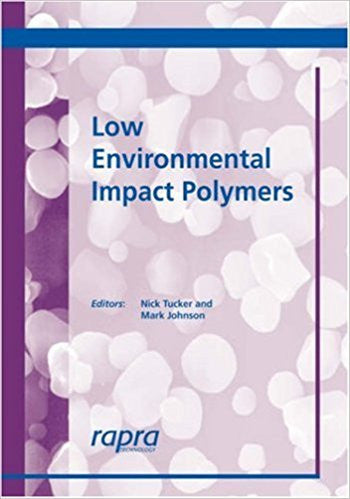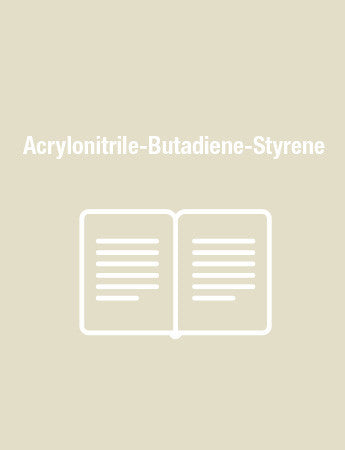Low Environmental Impact Polymers
In recent years the use of renewable resources as chemical feedstocks for the synthesis of polymeric materials has attracted considerable attention. The reason for such activity is due to the finite nature of traditional petrochemical derived compounds in addition to economic and environmental considerations. Thus a key goal of the coming years will be the development of sustainable raw materials for the chemical industry that will replace current fossil-based feedstocks. The challenge for researchers is to develop natural and man-made synthetics that would reduce the emission of gases.
This book gives a thorough overview of the manufacture and uses of low environmental impact polymers. This book will provide information for the experienced user of polymers wanting to use biodegradable materials and also be useful to designers, specifiers, end users and waste managers.
This book gives a thorough overview of the manufacture and uses of low environmental impact polymers. This book will provide information for the experienced user of polymers wanting to use biodegradable materials and also be useful to designers, specifiers, end users and waste managers.
CONTRIBUTORS
PREFACE
GUEST INTRODUCTION
1 SYNTHESIS OF POLYMERS FROM SUSTAINABLE RESOURCE ORIGIN RAW MATERIALS
1.1 Introduction
1.2 Carbohydrates as Renewable Resources
1.2.1 Cellulose
1.2.2 Starch
1.2.3 Hemicelluloses
1.2.4 Polylactic acid
1.2.5 Polyhydroxy-alkanoates (PHA)
1.3 Oils and Fats as Chemical Feedstocks
1.3.1 Hydroxylation (Ring Opening) of Vegetable Oil
1.3.2 Vegetable Oils as Feedstocks for Polyurethane Polymers
1.4 Conclusions
References
2 CHEMISTRY AND BIOLOGY OF POLYMER DEGRADATION
2.1 Introduction
2.2 Microbial Degradation of Natural and Synthetic Polyesters
2.2.1 Polyhydroxyalkanoates
2.2.2 Synthetic Polyesters
2.3 Biodegradable Blends and Composites: Preparation, Characterisation, and Properties
2.3.1 Microbial Polyesters
2.3.2 PHB and PHBV Blend with other Polymer Blends
2.3.3 Polycaprolactone (PCL)
2.3.4 Starch/Polymer Blends
2.3.5 Polyesters/High Amylose Starch Composites by Reactive Blending
2.3.6 PCL/PVOH
2.3.7 Polylactide (PLA)
2.3.8 PLA/Bionolle
2.4 Conclusions
Acknowledgements
References
3 QUANTIFYING THE RANGE OF PROPERTIES IN NATURAL RAW MATERIAL ORIGIN POLYMERS AND FIBRES
3.1 Introduction
3.2 Properties
3.3 Variability in Natural Origin Materials
3.4 The Influence of the Chemistry and Structure of Natural Origin Fibres Upon Their Properties
3.4.1 The Chemistry and Ultrastructure of Natural Fibres
3.4.2 The Influence of Fibre Ultrastructure Upon its Mechanical Properties
3.5 The Influence of Fibre Extraction, Isolation and Processing upon the Properties of Bast Fibres
3.5.1 Dew Retting
3.5.2 Water Retting
3.5.3 Enzyme Retting
3.5.4 Chemical Retting
3.6 The Influence of Fibre Damage upon the Mechanical Properties of Natural Fibres
3.6.1 Micro-Compressive Damage or ‘Kink Bands’ in Lignocellulosic Fibres
3.7 Mechanical Properties of Natural Fibres
3.7.1 Regenerated Cellulose Fibres
3.8 Fibre Testing
3.9 Biopolymers
3.9.1 Introduction
3.9.2 Biopolymer Types
3.9.3 Properties
References
4 NATURAL FIBRES AS FILLERS/REINFORCEMENTS IN THERMOPLASTICS
4.1 Introduction
4.1.1 Agro-Fibres and Their Use in Thermoplastics
4.2 Processing Considerations and Techniques
4.3 Properties
4.3.1 Mechanical Properties: Effects of Coupling and Fibre Content and Type
4.3.2 Effect of Fibre and Polymer
4.3.3 High Fibre-Filled Composites
4.3.4 Dynamic Mechanical Properties, Temperature and Creep Behaviour
4.3.5 Water Absorption
4.3.6 Recycling and Reprocessing
4.3.7 Accelerated Environmental Tests
References
5 MANUFACTURING TECHNOLOGIES FOR BIOPOLYMERS
5.1 Introduction
5.2 Manufacturing Methods
5.2.1 Spinning and Fibre Production
5.2.2 Extrusion and Compounding
5.2.3 Injection Moulding
5.2.4 Thermoset Injection Moulding
5.2.5 Film Blowing
5.2.6 Calendering and Coating
5.2.7 Blow Moulding
5.2.8 Thermoforming
5.2.9 Compression Moulding
5.2.10 Pultrusion
5.2.11 RTM (Resin Transfer Moulding) and RIM (Reaction Injection Moulding)
5.3 Processing Conditions
5.4 Additives or Admixtures
5.4.1 Plasticisers
5.4.2 Fillers
5.4.3 Flame Retardants
5.4.4 Lubricants
5.4.5 Colorants
5.4.6 Blowing (Foaming) Agents
5.4.7 Crosslinkers
5.4.8 Biocides and Antimicrobials
References
6 THE ECONOMICS AND MARKET POTENTIAL FOR LOW ENVIRONMENTAL IMPACT POLYMERS
6.1 Introduction
6.2 A Brief History of Biopolymers
6.3 Market Size
6.4 Classifications and Costs of Biopolymers
6.5 Current Uses of Biopolymers
6.6 Driving Forces
6.7 Political
6.7.1 Legislation
6.7.2 Government Initiatives
6.8 Economic
6.8.1 Increased Disposal Costs
6.8.2 Increased Competition
6.8.3 Polluter Pays
6.8.4 The Rising Costs of Finite Resources
6.9 Social
6.9.1 The ‘Greening’ of Consumers
6.9.2 Acceptance of Biopolymers
6.10 Technical
6.10.1 Economies of Scale
6.10.2 ‘Organic’ Recycling versus Mechanical Recycling
6.10.3 Further Development
6.10.4 Incorporation of Fillers
6.11 The Future for Biopolymers
6.11.1 Short-Term
6.11.2 Medium-Term
6.11.3 Long-Term
6.12 Conclusions
References
7 ECODESIGN
7.1 Introduction
7.2 Development of Ecodesign
7.2.1 Ecodesign Theory
7.2.2 Ecodesign Models
7.2.3 Ecodesign Practice
7.3 Implementing Ecodesign
7.3.1 LiDS Wheel
7.4 Examples of Ecodesign Projects
7.4.1 Case Study 1: Philips NV
7.4.2 Case Study 2: Dishlex
7.4.3 Case Study 3: Kodak’s Recyclable Camera
7.4.4 Case Study 4: Eco Kitchen
7.5 Conclusions
References
8 CASEIN ADHESIVES
8.1 History
8.2 Manufacture
8.3 Types of Casein Glues and Their Uses
8.3.1 Wood Glues
8.3.2 Label Pastes
8.3.3 Casein Latex
8.4 Current and Future Markets
References
9 PHA-BASED POLYMERS: MATERIALS FOR THE 21ST CENTURY
9.1 Introduction
9.2 History of PHA
9.3 Production
9.4 Applications
Reference
10 RENEWABLE RESOURCE-BASED POLYMERS
10.1 NatureWorks PLA – The Technology
10.2 Performance Without Sacrifice
10.3 Environmental Benefits and Disposal Options
10.4 ‘Committed to Sustainability Options’
11 POLYHYDROXYALKANOATES: THE NEXT GENERATION OF BIOPLASTICS
11.1 Introduction
11.1.1 Scientific Achievements
11.1.2 Commercial Developments
11.1.3 Environmental Concerns
11.2 Production of PHA
11.2.1 Fermentations
11.2.2 Production in Plants
11.2.3 Chemical Synthesis
11.2.4 Extraction and Purification
11.3 General Properties
11.3.1 Physico-Chemical Properties
11.3.2 Degradation
11.4 Industrial Applications
11.4.1 Compounding
11.4.2 Coating and Packaging
11.4.3 Plastic Food Services Items
11.4.4 Toner
11.4.5 Paint
11.4.6 Food Applications
11.4.7 Other Applications
11.5 Conclusion
References
12 THERMOSET PHENOLIC BIOPOLYMERS
12.1 Introduction
12.2 Natural Plant-Based Resins
12.2.1 General Reactions of Phenols
12.2.2 Cashew Nut Shell Liquid
12.3 Conclusions
Acknowledgement
References
13 COMMERCIALLY AVAILABLE LOW ENVIRONMENTAL IMPACT POLYMERS
Additional Information
References
ABBREVIATIONS
INDEX
PREFACE
GUEST INTRODUCTION
1 SYNTHESIS OF POLYMERS FROM SUSTAINABLE RESOURCE ORIGIN RAW MATERIALS
1.1 Introduction
1.2 Carbohydrates as Renewable Resources
1.2.1 Cellulose
1.2.2 Starch
1.2.3 Hemicelluloses
1.2.4 Polylactic acid
1.2.5 Polyhydroxy-alkanoates (PHA)
1.3 Oils and Fats as Chemical Feedstocks
1.3.1 Hydroxylation (Ring Opening) of Vegetable Oil
1.3.2 Vegetable Oils as Feedstocks for Polyurethane Polymers
1.4 Conclusions
References
2 CHEMISTRY AND BIOLOGY OF POLYMER DEGRADATION
2.1 Introduction
2.2 Microbial Degradation of Natural and Synthetic Polyesters
2.2.1 Polyhydroxyalkanoates
2.2.2 Synthetic Polyesters
2.3 Biodegradable Blends and Composites: Preparation, Characterisation, and Properties
2.3.1 Microbial Polyesters
2.3.2 PHB and PHBV Blend with other Polymer Blends
2.3.3 Polycaprolactone (PCL)
2.3.4 Starch/Polymer Blends
2.3.5 Polyesters/High Amylose Starch Composites by Reactive Blending
2.3.6 PCL/PVOH
2.3.7 Polylactide (PLA)
2.3.8 PLA/Bionolle
2.4 Conclusions
Acknowledgements
References
3 QUANTIFYING THE RANGE OF PROPERTIES IN NATURAL RAW MATERIAL ORIGIN POLYMERS AND FIBRES
3.1 Introduction
3.2 Properties
3.3 Variability in Natural Origin Materials
3.4 The Influence of the Chemistry and Structure of Natural Origin Fibres Upon Their Properties
3.4.1 The Chemistry and Ultrastructure of Natural Fibres
3.4.2 The Influence of Fibre Ultrastructure Upon its Mechanical Properties
3.5 The Influence of Fibre Extraction, Isolation and Processing upon the Properties of Bast Fibres
3.5.1 Dew Retting
3.5.2 Water Retting
3.5.3 Enzyme Retting
3.5.4 Chemical Retting
3.6 The Influence of Fibre Damage upon the Mechanical Properties of Natural Fibres
3.6.1 Micro-Compressive Damage or ‘Kink Bands’ in Lignocellulosic Fibres
3.7 Mechanical Properties of Natural Fibres
3.7.1 Regenerated Cellulose Fibres
3.8 Fibre Testing
3.9 Biopolymers
3.9.1 Introduction
3.9.2 Biopolymer Types
3.9.3 Properties
References
4 NATURAL FIBRES AS FILLERS/REINFORCEMENTS IN THERMOPLASTICS
4.1 Introduction
4.1.1 Agro-Fibres and Their Use in Thermoplastics
4.2 Processing Considerations and Techniques
4.3 Properties
4.3.1 Mechanical Properties: Effects of Coupling and Fibre Content and Type
4.3.2 Effect of Fibre and Polymer
4.3.3 High Fibre-Filled Composites
4.3.4 Dynamic Mechanical Properties, Temperature and Creep Behaviour
4.3.5 Water Absorption
4.3.6 Recycling and Reprocessing
4.3.7 Accelerated Environmental Tests
References
5 MANUFACTURING TECHNOLOGIES FOR BIOPOLYMERS
5.1 Introduction
5.2 Manufacturing Methods
5.2.1 Spinning and Fibre Production
5.2.2 Extrusion and Compounding
5.2.3 Injection Moulding
5.2.4 Thermoset Injection Moulding
5.2.5 Film Blowing
5.2.6 Calendering and Coating
5.2.7 Blow Moulding
5.2.8 Thermoforming
5.2.9 Compression Moulding
5.2.10 Pultrusion
5.2.11 RTM (Resin Transfer Moulding) and RIM (Reaction Injection Moulding)
5.3 Processing Conditions
5.4 Additives or Admixtures
5.4.1 Plasticisers
5.4.2 Fillers
5.4.3 Flame Retardants
5.4.4 Lubricants
5.4.5 Colorants
5.4.6 Blowing (Foaming) Agents
5.4.7 Crosslinkers
5.4.8 Biocides and Antimicrobials
References
6 THE ECONOMICS AND MARKET POTENTIAL FOR LOW ENVIRONMENTAL IMPACT POLYMERS
6.1 Introduction
6.2 A Brief History of Biopolymers
6.3 Market Size
6.4 Classifications and Costs of Biopolymers
6.5 Current Uses of Biopolymers
6.6 Driving Forces
6.7 Political
6.7.1 Legislation
6.7.2 Government Initiatives
6.8 Economic
6.8.1 Increased Disposal Costs
6.8.2 Increased Competition
6.8.3 Polluter Pays
6.8.4 The Rising Costs of Finite Resources
6.9 Social
6.9.1 The ‘Greening’ of Consumers
6.9.2 Acceptance of Biopolymers
6.10 Technical
6.10.1 Economies of Scale
6.10.2 ‘Organic’ Recycling versus Mechanical Recycling
6.10.3 Further Development
6.10.4 Incorporation of Fillers
6.11 The Future for Biopolymers
6.11.1 Short-Term
6.11.2 Medium-Term
6.11.3 Long-Term
6.12 Conclusions
References
7 ECODESIGN
7.1 Introduction
7.2 Development of Ecodesign
7.2.1 Ecodesign Theory
7.2.2 Ecodesign Models
7.2.3 Ecodesign Practice
7.3 Implementing Ecodesign
7.3.1 LiDS Wheel
7.4 Examples of Ecodesign Projects
7.4.1 Case Study 1: Philips NV
7.4.2 Case Study 2: Dishlex
7.4.3 Case Study 3: Kodak’s Recyclable Camera
7.4.4 Case Study 4: Eco Kitchen
7.5 Conclusions
References
8 CASEIN ADHESIVES
8.1 History
8.2 Manufacture
8.3 Types of Casein Glues and Their Uses
8.3.1 Wood Glues
8.3.2 Label Pastes
8.3.3 Casein Latex
8.4 Current and Future Markets
References
9 PHA-BASED POLYMERS: MATERIALS FOR THE 21ST CENTURY
9.1 Introduction
9.2 History of PHA
9.3 Production
9.4 Applications
Reference
10 RENEWABLE RESOURCE-BASED POLYMERS
10.1 NatureWorks PLA – The Technology
10.2 Performance Without Sacrifice
10.3 Environmental Benefits and Disposal Options
10.4 ‘Committed to Sustainability Options’
11 POLYHYDROXYALKANOATES: THE NEXT GENERATION OF BIOPLASTICS
11.1 Introduction
11.1.1 Scientific Achievements
11.1.2 Commercial Developments
11.1.3 Environmental Concerns
11.2 Production of PHA
11.2.1 Fermentations
11.2.2 Production in Plants
11.2.3 Chemical Synthesis
11.2.4 Extraction and Purification
11.3 General Properties
11.3.1 Physico-Chemical Properties
11.3.2 Degradation
11.4 Industrial Applications
11.4.1 Compounding
11.4.2 Coating and Packaging
11.4.3 Plastic Food Services Items
11.4.4 Toner
11.4.5 Paint
11.4.6 Food Applications
11.4.7 Other Applications
11.5 Conclusion
References
12 THERMOSET PHENOLIC BIOPOLYMERS
12.1 Introduction
12.2 Natural Plant-Based Resins
12.2.1 General Reactions of Phenols
12.2.2 Cashew Nut Shell Liquid
12.3 Conclusions
Acknowledgement
References
13 COMMERCIALLY AVAILABLE LOW ENVIRONMENTAL IMPACT POLYMERS
Additional Information
References
ABBREVIATIONS
INDEX
Nick Tucker has spent about half his working life in the manufacturing industry, working on production improvement in technical ceramics and as a line manager in fire retardant comfort foam manufacture. His gained his PhD at the University of Bradford, working on the manufacture of advanced composites and 2K mouldings by reaction injection moulding. Since he joined Warwick Manufacturing Group, he has developed a research portfolio covering the manufacture of low environmental impact biodegradable composites from sustainable resources – biological origin fibres such as hemp, flax, and jute, coupled with thermoset and thermoplastic biopolymers. Mark Johnson holds a Degree in Mechanical Engineering from the University of Northumbria and an MSc in Engineering Business Management from the University of Warwick. He is currently finishing his doctorate in Engineering Business Management at the University of Warwick. He has worked as a production engineer in composite fabrication, in addition to completing other projects including: kaizen implementation, time compression in service functions and optimisation of factory layouts. The areas of study of his doctorate are biodegradable composites, their fabrication, performance, biodegradability and the factors affecting their uptake and usage by industry




